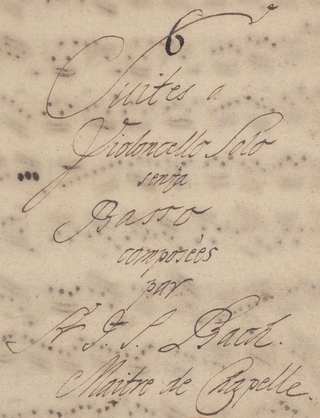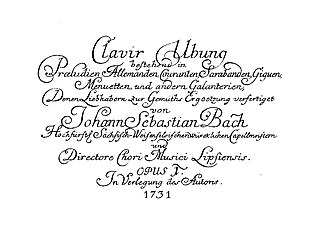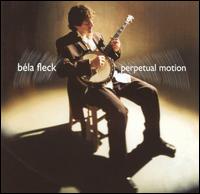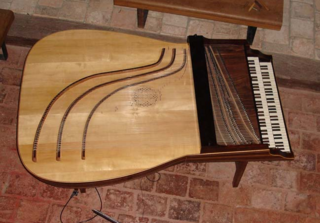
A suite, in Western classical music, is an ordered set of instrumental or orchestral/concert band pieces. It originated in the late 14th century as a pairing of dance tunes and grew in scope to comprise up to five dances, sometimes with a prelude, by the early 17th century. The separate movements were often thematically and tonally linked. The term can also be used to refer to similar forms in other musical traditions, such as the Turkish fasıl and the Arab nuubaat.

The six Cello Suites, BWV 1007–1012, are suites for unaccompanied cello by Johann Sebastian Bach (1685–1750). They are some of the most frequently performed solo compositions ever written for cello. Bach most likely composed them during the period 1717–1723, when he served as Kapellmeister in Köthen. The title given on the cover of the Anna Magdalena Bach manuscript was Suites à Violoncello Solo senza Basso.

The sonatas and partitas for solo violin are a set of six works composed by Johann Sebastian Bach. They are sometimes referred to in English as the sonatas and partias for solo violin in accordance with Bach's headings in the autograph manuscript: "Partia" was commonly used in German-speaking regions during Bach's time, whereas the Italian "partita" was introduced to this set in the 1879 Bach Gesellschaft edition, having become standard by that time. The set consists of three sonatas da chiesa in four movements and three partitas in dance-form movements. The 2nd Partita is widely known for its Chaconne, considered one of the most masterly and expressive works ever written for solo violin.

The Partitas, BWV 825–830, are a set of six keyboard suites written by Johann Sebastian Bach, published individually beginning in 1726, then together as Clavier-Übung I in 1731, the first of his works to be published under his own direction. They were, however, among the last of his keyboard suites to be composed, the others being the six English Suites, BWV 806-811 and the six French Suites, BWV 812-817, as well as the Overture in the French style, BWV 831.

Élisabeth Claude Jacquet de La Guerre was a French musician, harpsichordist and composer.

The English Suites, BWV 806–811, are a set of six suites written by the German composer Johann Sebastian Bach for harpsichord and generally thought to be the earliest of his 19 suites for keyboard, the others being the six French Suites, the six Partitas and the Overture in the French style. They probably date from around 1713 or 1714.

The French Suites, BWV 812–817, are six suites which Johann Sebastian Bach wrote for the clavier between the years of 1722 and 1725. Although Suites Nos. 1 to 4 are typically dated to 1722, it is possible that the first was written somewhat earlier.

Klavierbüchlein für Wilhelm Friedemann Bach is a collection of keyboard music compiled by the German Baroque composer Johann Sebastian Bach for his eldest son Wilhelm Friedemann. It is frequently referred to simply as Klavierbüchlein.

Perpetual Motion is an album of classical music released in 2001. The album is unusual in that none of the pieces featured on it are played on the instruments for which they were written. Arrangers Béla Fleck and Edgar Meyer won a Grammy in 2002 for their arrangement of Claude Debussy's "Doctor Gradus Ad Parnassum". The album also won a Grammy as Best Classical Crossover Album.
Robert de Visée was a French lutenist, guitarist, theorbist and viol player at the court of the kings Louis XIV and Louis XV, as well as a singer and composer for lute, theorbo and guitar.

The lautenwerck, alternatively called lute-harpsichord (lute-clavier) or keyboard lute, is a European keyboard instrument of the Baroque period. It is similar to a harpsichord, but with gut rather than metal strings, producing a mellow tone.
The Concerts royaux are chamber music suites by François Couperin written for the court of Louis XIV. Each consists of a prelude and a succession of dances in the order allemande, sarabande or courante, followed by others – but the suites are intended for listening more than dancing.
Laszlo Varga was a Hungarian-born American cellist who had a worldwide status as a soloist, recording artist, and authoritative cello teacher.
A Suite of Dances is a ballet choreographed by Jerome Robbins to Johann Sebastian Bach's Cello Suites. The ballet was created for Mikhail Baryshnikov and premiered on March 3, 1994, at the New York State Theater.

Baroque music refers to the period or dominant style of Western classical music composed from about 1600 to 1750. The Baroque style followed the Renaissance period, and was followed in turn by the Classical period after a short transition. The Baroque period is divided into three major phases: early, middle, and late. Overlapping in time, they are conventionally dated from 1580 to 1650, from 1630 to 1700, and from 1680 to 1750. Baroque music forms a major portion of the "classical music" canon, and is widely studied, performed, and listened to. The term "baroque" comes from the Portuguese word barroco, meaning "misshapen pearl". The works of George Frideric Handel and Johann Sebastian Bach are considered the pinnacle of the Baroque period. Other key composers of the Baroque era include Claudio Monteverdi, Domenico Scarlatti, Alessandro Scarlatti, Alessandro Stradella, Tomaso Albinoni, Johann Pachelbel, Henry Purcell, Antonio Vivaldi, Georg Philipp Telemann, Jean-Baptiste Lully, Jean-Philippe Rameau, Marc-Antoine Charpentier, Arcangelo Corelli, François Couperin, Johann Hermann Schein, Heinrich Schütz, Samuel Scheidt, Dieterich Buxtehude, Gaspar Sanz, José de Nebra, Antonio Soler, Carlos Seixas and others.
The Suite in G Minor, BWV 995, was transcribed for lute by composer Johann Sebastian Bach between the spring of 1727 and the winter of 1731 from his own Cello Suite No. 5, BWV 1011. It is in six movements:
Suite in E minor, BWV 996, is a musical composition written by Johann Sebastian Bach (1685–1750) between 1708 and 1717. It is probable that this suite was intended for Lautenwerck (lute-harpsichord). Because the lautenwerk is an uncommon instrument, it is in modern times often performed on the guitar or the lute.
The Partita No. 1 in B minor, BWV 1002 by Johann Sebastian Bach, is a piece for solo violin composed by 1720. This partita is formed in the traditional way that consists of an allemande, a courante, sarabande and gigue in the baroque style, except that this work substitutes a bourrée for the more typical gigue. Also, each movement is followed by a variation called double in French, which elaborates on the chords of the prior movement. The movements in order are:
The Suite in C minor, BWV 997, by Johann Sebastian Bach, exists in two versions:










